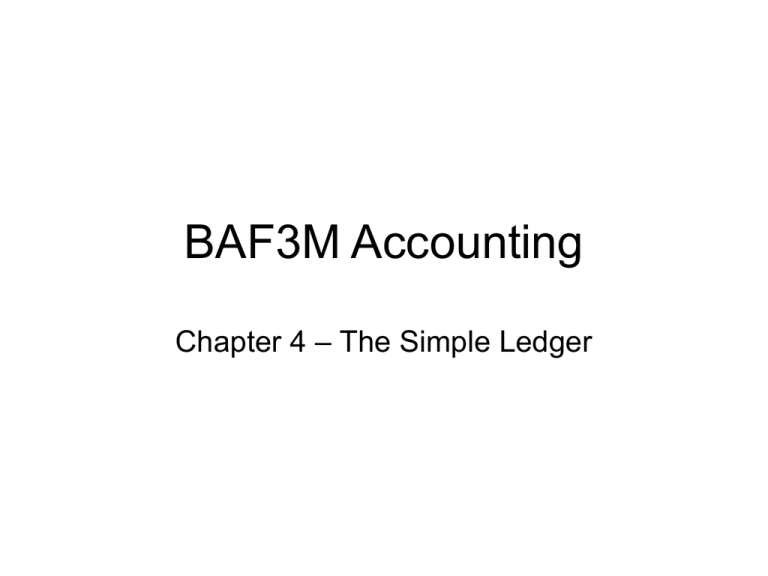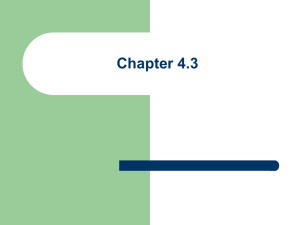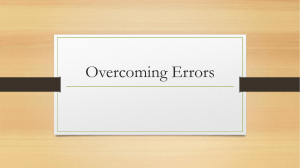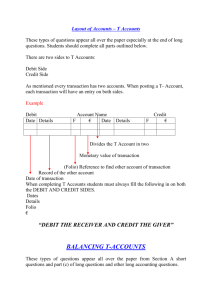BAF3M Accounting
advertisement

BAF3M Accounting Chapter 4 – The Simple Ledger 4.1 Ledger Accounts First off, some key distinctions: An “Account” is a page designed to record the changes for an individual item A “Ledger” is a group or file of accounts “Heath Ledger” is a late actor best known for playing The Joker in The Dark Knight 4.1 Ledger Accounts • There are many ways to create a ledger • In “real world” would be computerized • In “class” we will use paper to learn the accounting theory • Each item (account) on the B/S has its own page in the ledger (p. 89) • Use T-Accounts for this… 4.1 Ledger Accounts • T – accounts Called so because they look like a T Account name left right 4.1 Ledger Accounts • It’s key to understand what side of the ledger the beginning balance is on • ASSETS LEFT • LIABILITIES + OE RIGHT 4.1 Ledger Accounts • To Do • 1) Copy the T account relationship on page 90. • Do Exercises 1, 2 • We’ll do 3 together • Do Exercise 4 4.2 Debit and Credit Theory • Debit (DR) LEFT SIDE • Credit (CR) RIGHT SIDE • Asset accounts have DEBIT values • Liab & OE accounts have CREDIT values 4.2 Debit and Credit Theory • Rules of Debit and Credit – For each type of account, record increases on its beginning value side and decrease on the other side – EX. ASSETS increases – left -- debit decreases – right -- credit 4.2 Debit and Credit Theory Types of Accounts Beginning Value Side Increases Decreases ASSET accounts LEFT DEBIT CREDIT LIABILITY & OWNER’S EQUITY accounts RIGHT CREDIT DEBIT 4.2 Debit and Credit Theory • Memorize this: ASSETS + DR CR = LIABILITIES + OWNER’S EQUITY DR + CR Follow along with scenario on pgs 94 - 100 + DR CR 4.2 Debit and Credit Theory • TO DO: – 4.2 Questions #1 – 6, 9 – 11; pg 102 – 4.2 Exercises 1 – 4 Pg 102-4 4.3 Account Balances and Terminology • Calculating the Balance of an account – 2 steps • Step 1: Add the two sides separately (your totals are called ‘pin totals’ or ‘pencil footings’) • Step 2: Subtract the smaller total from the larger total, write the result beneath the larger number and circle it • See Example Figure 4.6 p. 94 4.3 Account Balances and Terminology • • • • Interpreting the Balance of an Account Exceptional Account Balances The Bank Account Buying & Selling on Credit – Read each section (p.94) and make your own notes 4.4 Trial Balance WHY DO WE DO A TRIAL BALANCE? • Periodically it is necessary to check the accuracy of the ledger (your T-accounts) • To do this we use a form called a TRIAL BALANCE 4.4 Trial Balance WHAT IS A TRIAL BALANCE? • TRIAL BALANCE - is simply the listing of the account balances in a ledger – it is used to see if the dollar value of the accounts with debit balances is equal to the dollar value of the accounts with credit balances 4.4 Trial Balance KEY TERMS • IN BALANCE – if the debits equal the credits • OUT OF BALANCE – if the debits don’t equal the credits STEPS TO CREATE A TRIAL BALANCE 1) Include the heading (who, what, when) 2) List all the accounts and their balances. 3) Place the debit balances in a debit column and the credit balances in a credit column. 4) Add up the 2 columns. 5) See if the 2 column totals are the same. Trial Balance Example Metropolitan Movers Trial Balance 17-Sep-08 Cash $ 8 Account Receivable - B. Cava 2 8 Account Receivable - K. Lincoln 1 4 Equipment 13 4 Trucks 42 5 Account Payable - Central Supply Loan Payable - Mecury Finance Capital - J. Hofner 7 0 0 5 0 5 0 0 0 0 $1 7 5 0 25 1 7 0 34 1 0 5 - $61 0 2 5 - $61 0 2 5 - 4.4 Trial Balance If the 2 columns balance does that mean I did it right? NO Sometimes the errors made were incorrect entries that just happened to be balanced .. This takes some skill to detect and solve





